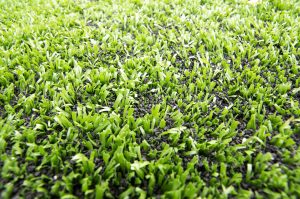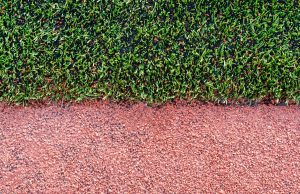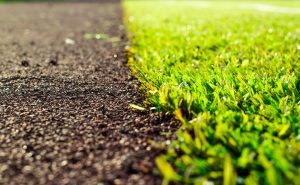Synthetic Turf
What Is Synthetic Turf?
Synthetic turf is an artificial field crafted from plastic fibers and an infill material designed to emulate natural grass. The infill material is commonly made from old tires and processed to become tire crumb rubber pieces. Over the past several decades, synthetic turf has gained popularity due to its low maintenance requirements, durability, and longevity compared to natural grass fields.

Concerns Regarding Synthetic Turf
Since the 1980s several collegiate and professional sporting teams have reported players being diagnosed with a wide variety of cancer types after having played on synthetic fields during their career. Although all of the case findings suggest that the chemical exposures were limited and the cancer cases were likely due to chance, many individuals were still concerned about the chemical exposure that athletes face when playing on synthetic fields. In response to a growing concern, the Federal Research Action Plan on Recycled Tire Crumb Used in Playing Fields and Playgrounds (FRAP) was launched in 2016. FRAP is a multi-agency research effort, including the Center for Disease Control (CDC), the Agency for Toxic Substances and Disease Registry (ATSDR), the Environmental Protection Agency (EPA), and the Consumer Product Safety Commission (CPSC), focusing on assessing human exposure.
- Part one of FRAP was released in 2019 and determined that while metals, semi volatile organic compounds (SVOCs), and volatile organic compounds (VOCs) are present in the tire crumb rubber, human exposure appears to be limited based on what is released into air or simulated biological fluid.
- The second part of FRAP, which focused on biomonitoring the uptake of polycyclic aromatic hydrocarbons (PAHs) when athletes are playing on tire crumb rubber fields, was released in April of 2024. This study supports the conclusions that although chemicals are present in the tire crumb rubber and exposures can occur, they are limited.
Several cities, such as Boston and Washinton D.C. have banned the use of tire crumb rubber infill following the reports of adverse health effects and growing concerns.
Physical Injuries
Several studies looked into the lower extremity injury rates when playing on tire crumb rubber and natural grass.
- Ankle and foot injuries were more prevalent when playing on tire crumb rubber synthetic turf compared to natural grass.
- Knee injuries, such as anterior cruciate ligament (ACL) injuries, were more prevalent when playing on tire crumb rubber synthetic turf for female athletes compared to males.
- Knee injuries were also more prevalent in football players on tire crumb rubber synthetic fields.
- Hip injuries were reported to be the same for all types of playing fields.

Heat Illnesses
Synthetic fields made of tire crumb rubber have been noted to reach significantly higher temperatures compared to other field types studied.
- Playing on synthetic turf can melt shoes, blister hands and feet, and induce dehydration and heatstroke.
- Tire crumb rubber synthetic fields can be 30-50 °F hotter than natural grass fields.
- Other alternatives, such as the southern pine infill, have been found to be 33 °F cooler than tire crumb rubber synthetic turf.
- Scientific literature reviews suggest that adults and children playing on synthetic fields for prolonged periods are at an increased risk for heat-related illnesses.
- Several universities have found that watering the synthetic fields can reduce temperatures temporarily.
Other Infill Materials
There are many products that have been developed and used as a tire crumb rubber option infill material to tire crumb rubber including sand, southern pine wood particles, coconut husk, and cork.

Resources
Agency for Toxic Substances and Disease Registry Federal Research Action Plan
U.S. Environmental Protection Agency Tire Crumb Used on Playing Fields
